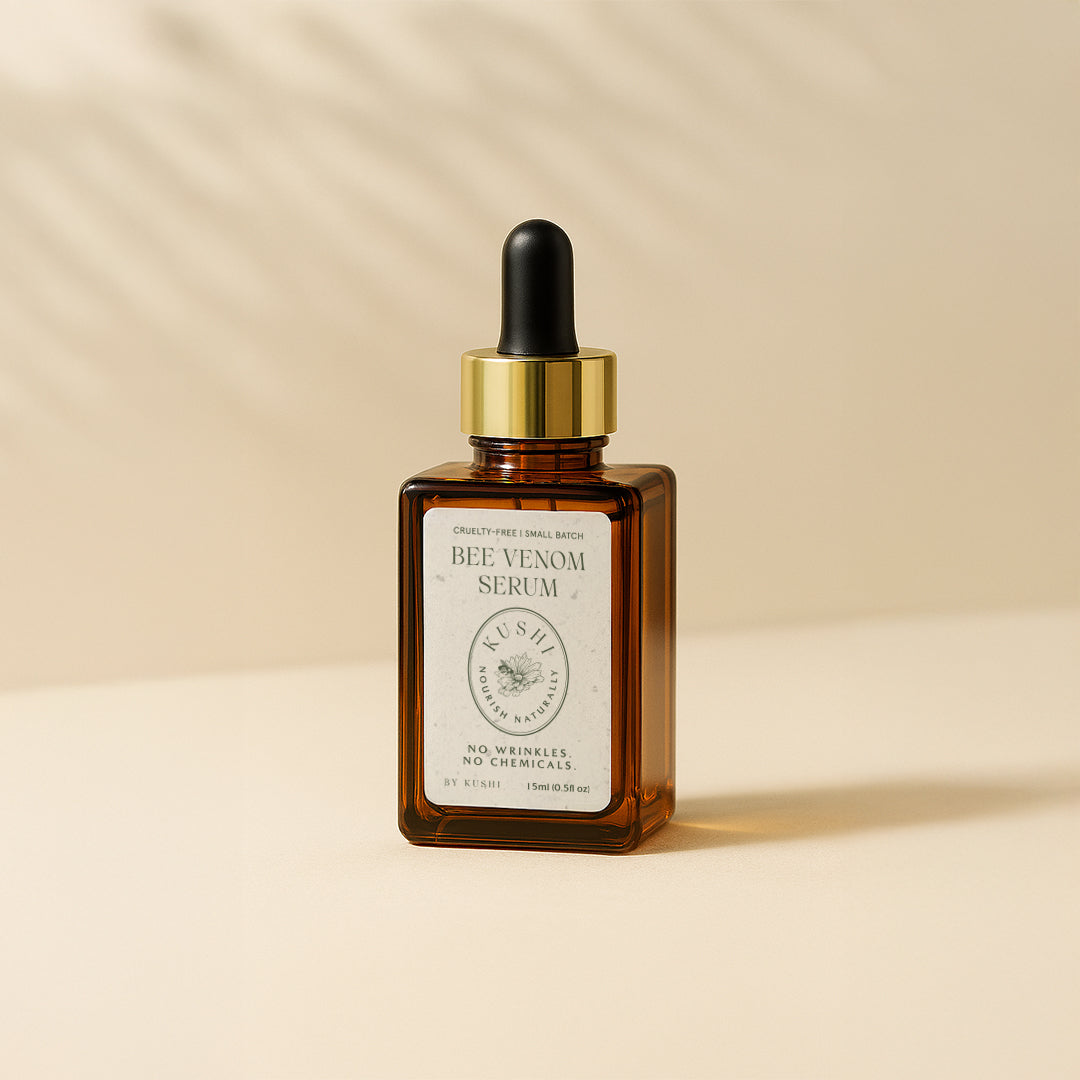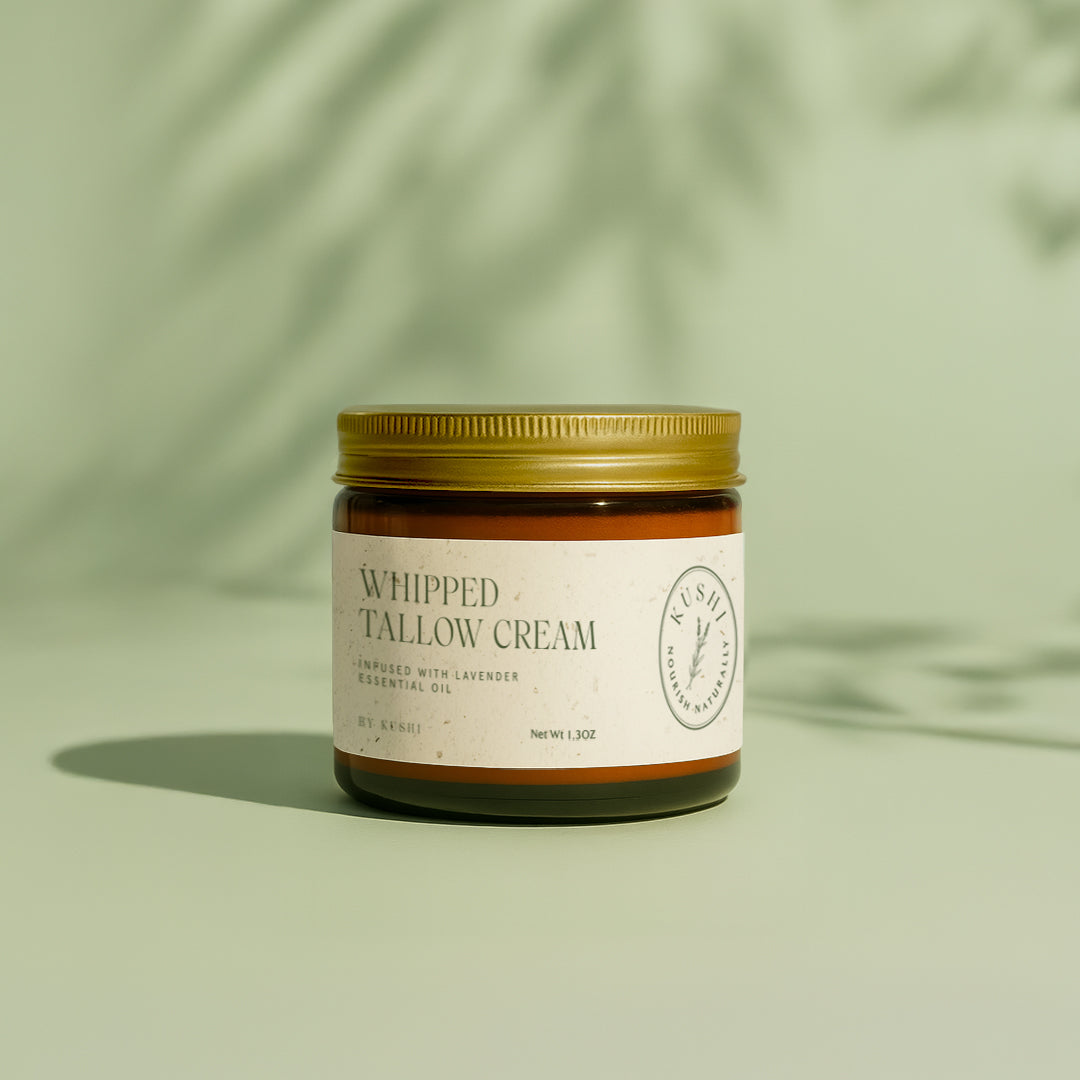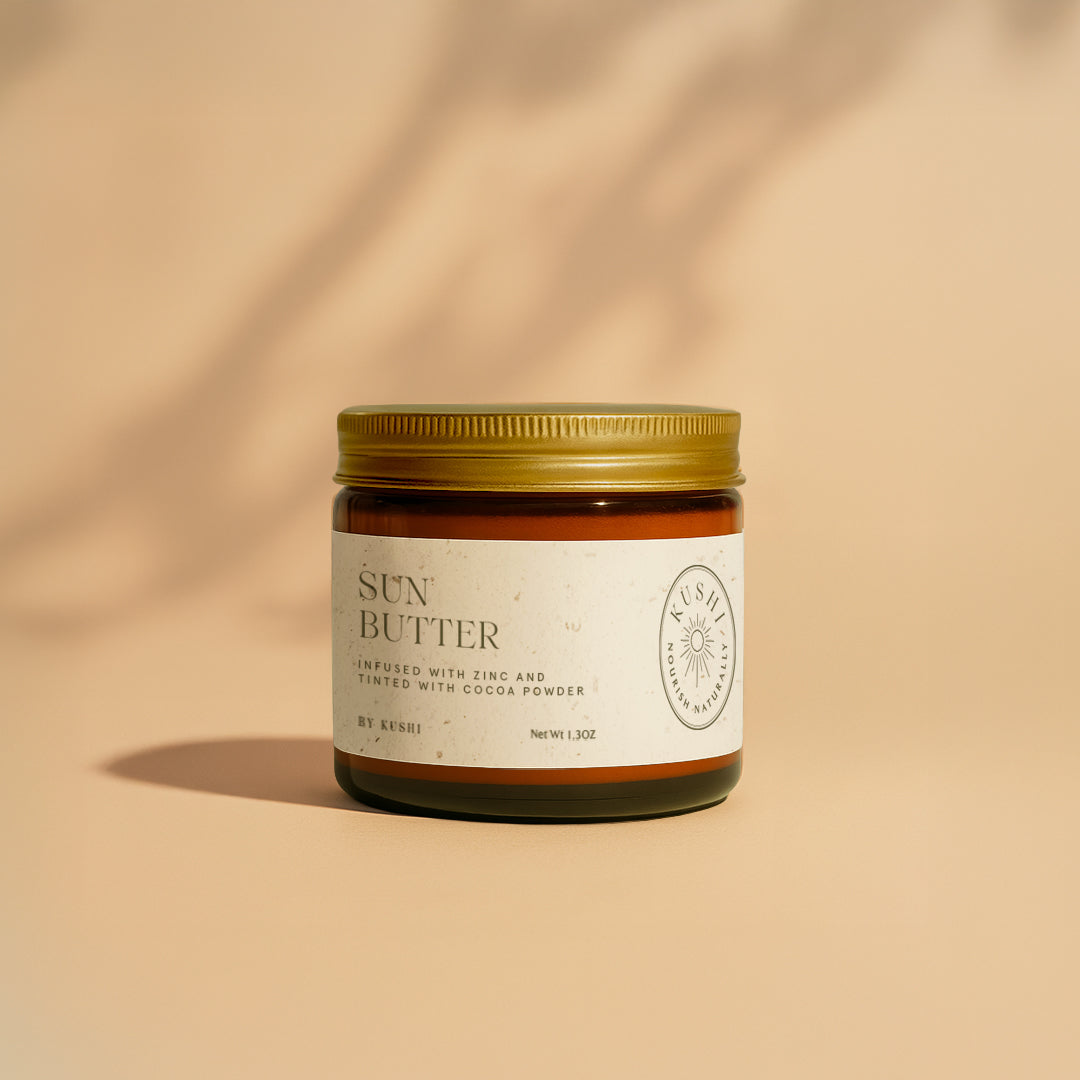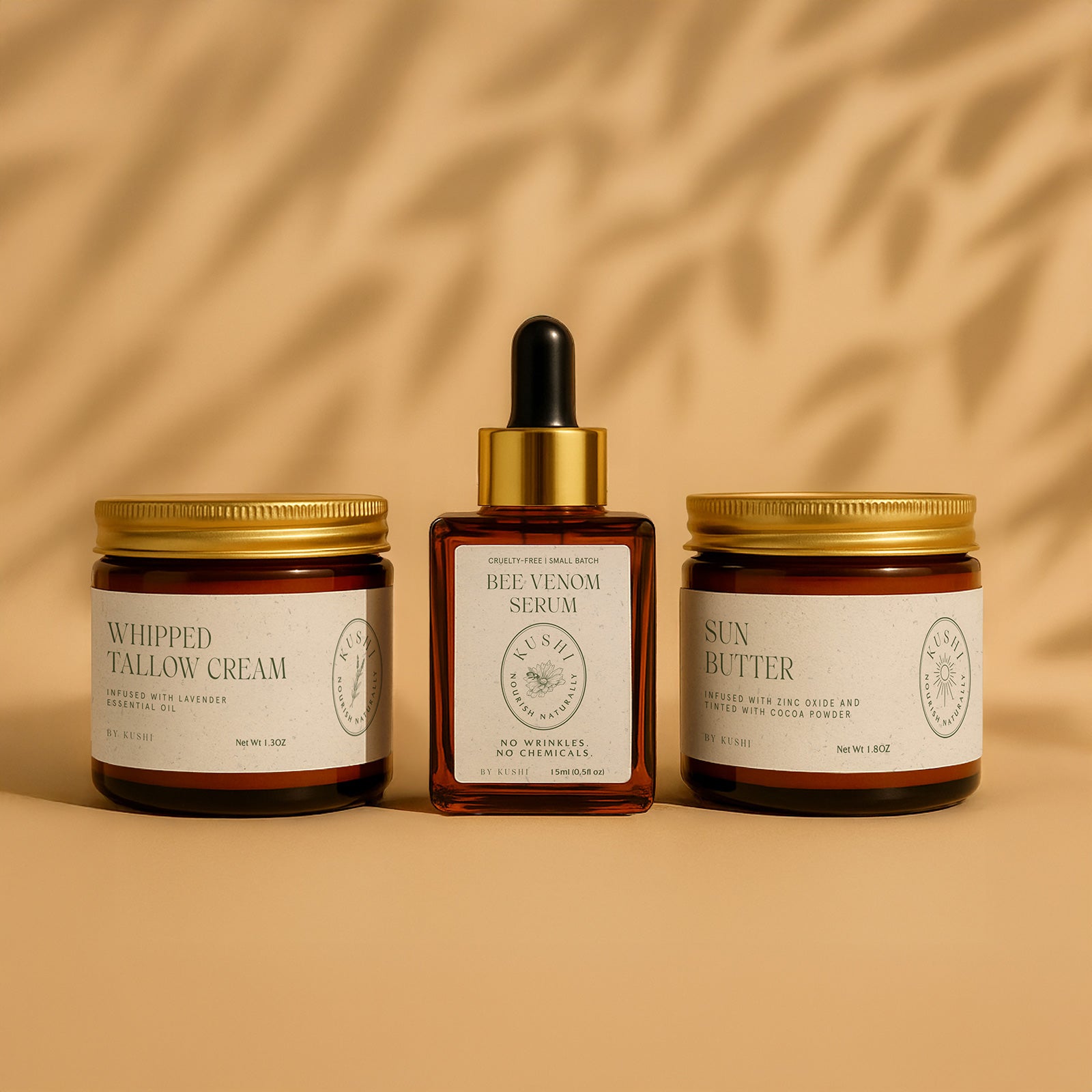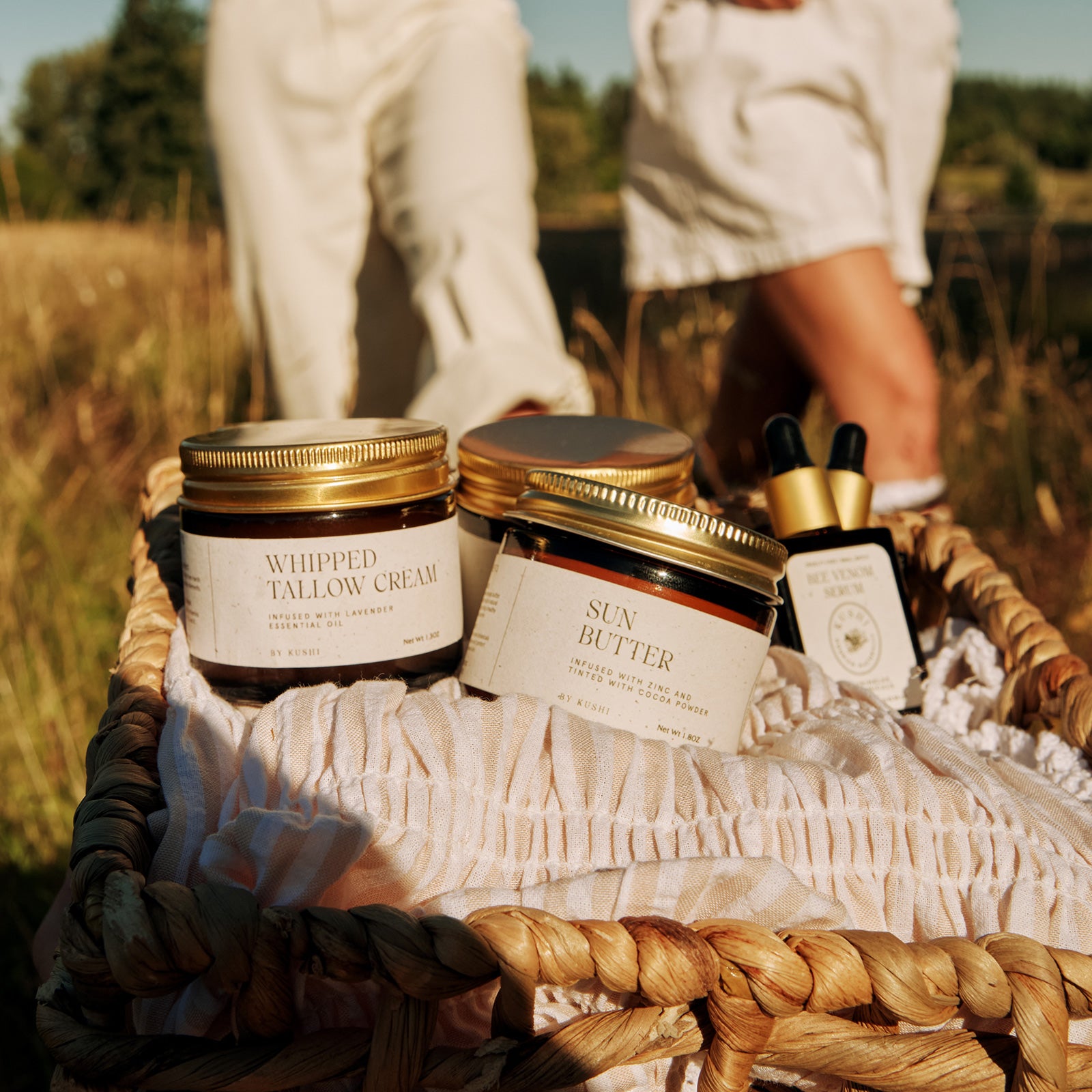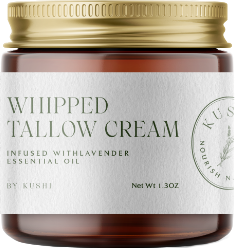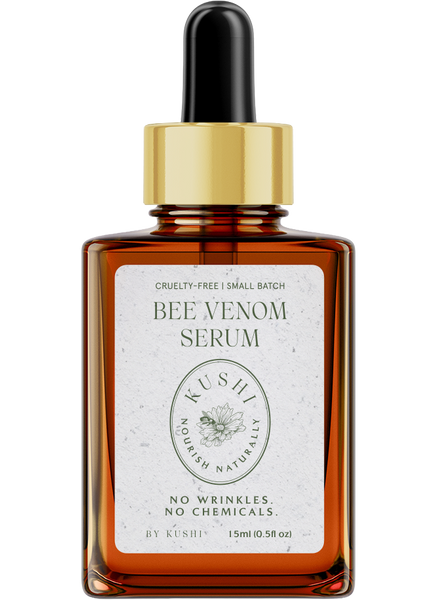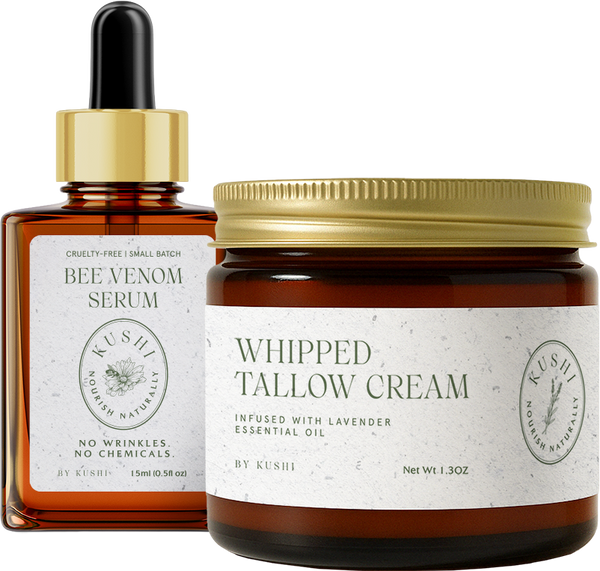Key Takeaways:
-
Barrier Repair Begins with Simplicity: Minimal routines using whole, skin-compatible ingredients like tallow are more effective than multi-step systems for damaged skin.
-
Nature Offers Deep Nourishment: Ingredients like grass-fed tallow and organic lavender oil support the skin’s natural healing processes without irritation or synthetics.
-
Healing Involves More Than Products: Environmental stress and lifestyle habits all influence the skin barrier. A holistic approach is essential for long-lasting results.
Why does skin sometimes feel more like paper than protection — dry, reactive, and completely out of balance? When the skin barrier breaks down, even the gentlest breeze or cleanest product can feel like too much. It's not just a surface issue; it signals that your skin’s natural defense system needs repair.
At Kushi, we honor the wisdom of slow, intentional skincare. Like the nutrient-dense Whipped Tallow Cream, our formulations are grounded in tradition, crafted from whole, recognizable ingredients, and designed to restore skin without compromise. We don’t just make skincare; we offer rituals supporting real, lasting healing for sensitive souls and skin alike.
In this piece, we’ll explain how to repair skin barrier damage using simple, natural solutions rooted in the earth so your skin can feel strong, supported, and whole again.
What Is The Skin Barrier And Why Does It Matter?
Imagine your skin as a living wall — your body’s first line of defense against the outside world. This barrier comprises lipids (healthy fats), skin cells, and natural moisturizers that work together like bricks and mortar. Its job? To lock in hydration and avoid irritants, bacteria, and environmental stressors.
When the barrier is strong, skin feels calm, balanced, and visibly healthy. But when it’s weakened, moisture escapes, and harmful elements can sneak in, leading to dryness, redness, inflammation, or breakouts. Many people focus on treating surface symptoms, but true skin healing starts at the foundation: rebuilding and maintaining the skin barrier itself.
Understanding how to repair skin barrier function means tuning into your skin’s natural needs. It’s not about overpowering it with actives or stripping it down with harsh cleansers — it’s about giving it what it’s quietly asking for: nourishment, simplicity, and support.
Common Signs Your Skin Barrier Is Damaged
Your skin speaks subtly, and when the barrier is compromised, it gets louder. You might notice flakiness that doesn’t seem to go away, redness that flares up unexpectedly, or a sudden sensitivity to products that used to feel fine. These are more than surface-level frustrations — they’re your skin’s way of asking for deeper care.
Other signs include:
-
Persistent dryness even after moisturizing: No matter how rich or hydrating your products are, your skin still feels parched. This is often because the barrier isn’t effectively holding moisture in, allowing hydration to escape too quickly.
-
Itchiness or tightness, especially after cleansing: Cleansing should leave your skin feeling refreshed, not uncomfortable. A damaged barrier can become overly reactive, leading to sensations of tightness or itchiness, even with mild products.
-
Breakouts or inflammation that don’t respond well to your usual routine: When your skin’s defenses are down, it can become more vulnerable to bacteria and irritation. This can lead to stubborn breakouts or flare-ups that feel different from your typical skin behavior.
-
A shiny yet dehydrated appearance, where your skin feels both oily and dry: This confusing mix of textures often signals an imbalance. Your skin may overproduce oil to compensate for lost moisture, while still lacking the hydration it needs.
-
Stinging or burning when applying products — even gentle ones: If your skin reacts negatively to products that used to feel soothing, it’s a clear sign your barrier is compromised. This hypersensitivity is your skin’s way of protecting itself from further irritation.
Recognizing these signs is the first step in learning how to repair the skin barrier healthfully. When you understand the signals, you can respond with intention, choosing ingredients and rituals that soothe rather than strip.
What Causes Skin Barrier Damage?
The skin barrier is brilliant, but it isn’t invincible. Many of the habits we think are helping can actually be doing more harm than good, especially when products or routines ignore the skin’s natural rhythms. To better understand how to repair skin barrier issues at the root, we need to recognize the subtle ways damage occurs:
-
Harsh Cleansers And Exfoliants: Cleansers and scrubs that promise a deep clean often strip away more than dirt — they remove the skin’s natural oils and lipids that form its protective layer. Over-cleansing or using aggressive exfoliants disrupts the skin’s microbiome, leaving it more vulnerable to irritation and dehydration. This constant stripping weakens the skin’s defense, making it less able to retain moisture and resist environmental stressors.
-
Overuse of Active Ingredients: While actives like retinol and exfoliating acids offer benefits, they can easily overwhelm the skin without balance. Applying too many strong ingredients at once can thin the barrier, triggering sensitivity, redness, and inflammation. A skin-first mindset means prioritizing restoration over results, especially when the barrier is compromised.
-
Environmental Stressors: Exposure to wind, sun, pollution, and extreme weather conditions can slowly chip away at the skin’s resilience. These elements dehydrate the skin and introduce oxidative stress, which weakens its ability to repair itself naturally. Over time, constant environmental assault can leave the skin barrier depleted and reactive.
-
Lifestyle Factors: Sleep, nutrition, and stress affect how you feel and shape your skin's behavior. Poor sleep and high stress levels can increase inflammation and slow cellular turnover, impairing the skin’s natural healing process. Even the most natural topical treatments may struggle to restore balance without internal support.
-
Using Too Many Products At Once: A crowded skincare routine can confuse your skin rather than nourish it. Layering too many serums, toners, and treatments can disrupt the skin's pH and compromise its ability to regulate itself. Simplicity often leads to the most sustainable results when learning how to repair skin barrier healthfully.

The Best Natural Ingredients To Repair Your Skin Barrier
True healing starts with the ingredients you choose. When your skin barrier is damaged, it craves gentle and deeply restorative nourishment, not synthetic fixes or trendy formulas. The most effective remedies are often the ones rooted in tradition, made with whole, recognizable ingredients your skin already understands:
Grass-Fed, Grass-Finished Beef Tallow
Sourced from Canadian family-run farms, 100% grass-fed and finished beef tallow is a time-honored skincare ingredient that mirrors the skin’s structure. Rich in fat-soluble vitamins A, D, E, and K — and packed with powerful antioxidants — tallow deeply nourishes the skin while supporting natural repair processes. Its bioavailability means the skin recognizes it instantly, allowing deep absorption without clogging pores or causing irritation.
Certified Organic Lavender Essential Oil
Lavender isn’t just calming to the senses, but it also offers powerful skin-soothing benefits. Certified organic lavender essential oil helps reduce inflammation, calm redness, and promote healing, making it ideal for sensitive or barrier-damaged skin. Its antimicrobial properties support a balanced microbiome, while its gentle scent creates a ritual of relaxation and care.
How To Build A Simple, Holistic Skin Barrier Repair Routine
Repairing your skin barrier doesn’t require a complicated routine or a dozen new products. The more fragile your skin feels, the more it benefits from slowing down and focusing on fewer, high-quality ingredients. A holistic approach prioritizes nourishment, rest, and ritual, giving your skin the space to restore itself naturally:
Begin With A Gentle, Oil-Based Cleanser
Swap out foaming or acid-based cleansers for an oil or balm cleanser that respects your skin’s natural oils. These cleansers dissolve impurities without stripping away the protective layer your skin relies on. Think of this as the first act of kindness in your barrier-repair ritual.
Skip The Harsh Exfoliants — Let Skin Rest
When your skin is compromised, less is more. Resist the urge to exfoliate and instead allow your skin to rebalance itself. Gentle textures like soft washcloths or a splash of lukewarm water are enough during the healing phase.
Use A Rich, Natural Moisturizer Like Tallow Cream
Moisture is essential, but not all moisturizers are created equal. Tallow — especially from 100% grass-fed, grass-finished sources — delivers skin-loving vitamins and healthy fats in a form your skin readily accepts. A whipped tallow cream seals in hydration, supports deep repair, and brings lasting comfort to dry, irritated skin.
Protect And Soothe With A Natural Occlusive
Lock in moisture with a final layer that shields and softens. Tallow, combined with essential oils like organic lavender, forms a breathable barrier that protects against environmental stress without suffocating the skin. This final step is key for maintaining the hydration and nourishment you've just delivered.
Be Consistent, Not Reactive
Healing a damaged skin barrier takes time, patience, and consistency. Avoid switching products too frequently; instead, give your skin a chance to respond and recover. A steady, intentional routine is far more powerful than a constantly changing one.
Final Thoughts
Your skin barrier is more than a protective layer — it reflects your overall well-being. Caring for it requires a shift in perspective: from quick fixes to long-term support, from overdoing to intentional simplicity. When you choose ingredients that align with your body’s natural rhythms, you’re not just repairing damage but building a foundation of lasting resilience. Trust in the process, stay consistent, and let your skincare routine become a daily act of restoration and respect.
Read also:
Frequently Asked Questions About How To Repair Skin Barrier
How long does it take to repair a damaged skin barrier naturally?
On average, a mildly damaged skin barrier can take two to four weeks to repair with the right natural support. More severe cases may take longer, especially if lifestyle factors contribute to inflammation. Consistency and simplicity are key in supporting recovery.
Can a damaged skin barrier cause breakouts or acne?
Yes, when the barrier is compromised, the skin becomes more prone to bacterial imbalance and clogged pores. This often results in breakouts, especially when the skin overproduces oil to compensate for lost moisture. A healthy barrier helps regulate oil production and prevent flare-ups.
Is it okay to wear makeup while trying to repair my skin barrier?
Light, breathable makeup may be fine, but heavy or long-wear formulations can further irritate a weakened barrier. Look for clean, non-comedogenic ingredients and always remove makeup gently. Giving your skin makeup-free days can speed up the repair process.
How can weather changes affect skin barrier health?
Cold, dry air or intense sun exposure can sap moisture from the skin and increase sensitivity. These environmental shifts challenge the skin’s ability to stay balanced. Seasonal transitions are a good time to revisit your routine and reinforce your barrier with nourishing products.
What ingredients should I avoid while repairing my skin barrier?
Avoid synthetic fragrances, alcohol-based toners, and strong acids or retinoids until your skin feels calm and resilient. These can all trigger further irritation. Gentle, whole-ingredient formulas are much safer during recovery.
Does hydration play a role in skin barrier health?
Yes, water is essential for skin function. Dehydration makes it harder for the skin to repair itself and increases transepidermal water loss. Drinking enough water and using hydrating products support both internal and external balance.
How often should I apply moisturizer when repairing my skin barrier?
Twice daily—morning and night—is ideal, though some may benefit from a midday application if their skin feels dry. Using a rich, nutrient-dense formula like tallow cream helps maintain long-lasting hydration. Apply to slightly damp skin to lock in moisture effectively.
Can I use facial oils with tallow-based products?
Yes, facial oils can complement tallow creams if used mindfully. Apply oils after or mixed with tallow to create a deeper occlusive layer. Just be sure the oil is non-comedogenic and suits your skin type.
Does facial massage help support skin barrier recovery?
Gentle facial massage can increase circulation and support lymphatic flow, which promotes skin repair. Always use a nourishing balm or cream to protect the skin while massaging. Avoid tugging or pulling, especially on irritated or inflamed areas.
Should I change my pillowcases or towels more often during skin barrier repair?
Yes — using clean, soft fabrics helps prevent added irritation and bacterial buildup. Natural fabrics like cotton or bamboo are gentle on sensitive skin. Washing pillowcases and towels 2–3 times a week can make a noticeable difference in your skin’s healing.
